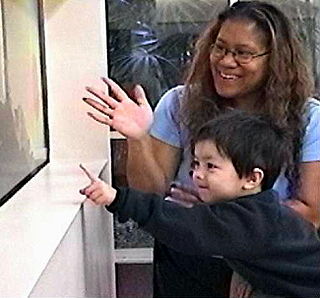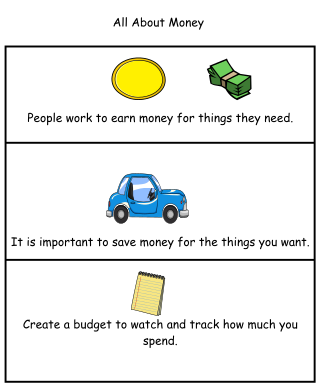Related Research Articles

Asperger syndrome (AS), also known as Asperger's syndrome, is a neurodevelopmental condition characterized by significant difficulties in social interaction and nonverbal communication combined with restricted and repetitive patterns of behavior and interests. The syndrome has been merged with other conditions into autism spectrum disorder (ASD) and is no longer considered a stand-alone diagnosis. It was considered to differ from other diagnoses that were merged into ASD by relatively unimpaired spoken language and intelligence.
The diagnostic category pervasive developmental disorders (PDD), as opposed to specific developmental disorders (SDD), was a group of disorders characterized by delays in the development of multiple basic functions including socialization and communication. It was defined by the Diagnostic and Statistical Manual of Mental Disorders (DSM), and the International Classification of Diseases (ICD).
Developmental disorders comprise a group of psychiatric conditions originating in childhood that involve serious impairment in different areas. There are several ways of using this term. The most narrow concept is used in the category "Specific Disorders of Psychological Development" in the ICD-10. These disorders comprise developmental language disorder, learning disorders, motor disorders, and autism spectrum disorders. In broader definitions ADHD is included, and the term used is neurodevelopmental disorders. Yet others include antisocial behavior and schizophrenia that begins in childhood and continues through life. However, these two latter conditions are not as stable as the other developmental disorders, and there is not the same evidence of a shared genetic liability.

Diagnoses of autism have become more frequent since the 1980s, which has led to various controversies about both the cause of autism and the nature of the diagnoses themselves. Whether autism has mainly a genetic or developmental cause, and the degree of coincidence between autism and intellectual disability, are all matters of current scientific controversy as well as inquiry. There is also more sociopolitical debate as to whether autism should be considered a disability on its own.
Autism spectrum disorders (ASD) are neurodevelopmental disorders that begin in early childhood, persist throughout adulthood, and affect three crucial areas of development: communication, social interaction and restricted patterns of behavior. There are many conditions comorbid to autism spectrum disorders such as attention-deficit hyperactivity disorder and epilepsy.
Discrete trial training (DTT) is a technique used by practitioners of applied behavior analysis (ABA) that was developed by Ivar Lovaas at the University of California, Los Angeles (UCLA). DTT uses direct instruction and reinforcers to create clear contingencies that shape new skills. Often employed as an early intensive behavioral intervention (EIBI) for up to 30–40 hours per week for children with autism, the technique relies on the use of prompts, modeling, and positive reinforcement strategies to facilitate the child's learning. It previously used aversives to punish unwanted behaviors. DTT has also been referred to as the "Lovaas/UCLA model", "rapid motor imitation antecedent", "listener responding", errorless learning", and "mass trials".
Applied behavior analysis (ABA), also called behavioral engineering, is a psychological intervention that applies approaches based upon the principles of respondent and operant conditioning to change behavior of social significance. It is the applied form of behavior analysis; the other two forms are radical behaviorism and the experimental analysis of behavior.
The following outline is provided as an overview of and topical guide to autism:

Autism therapies include a wide variety of therapies that help people with autism, or their families. Such methods of therapy seek to aid autistic people in dealing with difficulties and increase their functional independence.
Pivotal response treatment (PRT), also referred to as pivotal response training, is a naturalistic form of applied behavior analysis used as an early intervention for children with autism that was pioneered by Robert Koegel and Lynn Kern Koegel. PRT advocates contend that behavior hinges on "pivotal" behavioral skills—motivation and the ability to respond to multiple cues—and that development of these skills will result in collateral behavioral improvements. In 2005, Richard Simpson of the University of Kansas identified pivotal response treatment as one of the four scientifically based treatments for autism.
The floortime or Developmental, Individual-differences, Relationship-based (DIR) model is a developmental model for assessing and understanding any child's strengths and weaknesses. It has become particularly effective at identifying the unique developmental profiles and developing programs for children experiencing developmental delays due to autism, autism spectrum disorders, or other developmental disorders. This Model was developed by Dr. Stanley Greenspan and first outlined in 1979 in his book Intelligence and Adaptation. Evidence for the efficacy of DIR/Floortime includes results from randomized controlled trials of DIR/Floortime and the DIR/Floortime-based P.L.A.Y. Project; because of various limitations in these studies, the existing evidence is deemed to "weakly support" the efficacy of Floortime.

Classic autism, also known as childhood autism, autistic disorder, (early) infantile autism, infantile psychosis, Kanner's autism,Kanner's syndrome, or (formerly) just autism, is a neurodevelopmental condition first described by Leo Kanner in 1943. It is characterized by atypical and impaired development in social interaction and communication as well as restricted, repetitive behaviors, activities, and interests. These symptoms first appear in early childhood and persist throughout life.

Autism, formally called autism spectrum disorder (ASD) or autism spectrum condition (ASC), is a neurodevelopmental disorder characterized by deficits in social communication and social interaction, and repetitive or restricted patterns of behaviors, interests, or activities, which can include hyper- and hyporeactivity to sensory input. Autism is a spectrum disorder, meaning that it can manifest very differently in each person. For example, some are nonspeaking, while others have proficient spoken language. Because of this, there is wide variation in the support needs of people across the autism spectrum.
Sex and gender differences in autism exist regarding prevalence, presentation, and diagnosis.

The Picture Exchange Communication System (PECS) is an augmentative and alternative communication system developed and produced by Pyramid Educational Consultants, Inc. PECS was developed in 1985 at the Delaware Autism Program by Andy Bondy, PhD, and Lori Frost, MS, CCC-SLP. The developers of PECS noticed that traditional communication techniques, including speech imitation, sign language, and picture point systems, relied on the teacher to initiate social interactions and none focused on teaching students to initiate interactions. Based on these observations, Bondy and Frost created a functional means of communication for individuals with a variety of communication challenges. Although PECS was originally developed for young children with autism spectrum disorder (ASD), its use has become much more widespread. Through the years, PECS has been successfully implemented with individuals with varying diagnoses across the aged span. PECS is an evidence-based practice that has been highly successful with regard to the development of functional communication skills.
Nonverbal autism is a subset of autism spectrum where the person does not learn how to speak. It is estimated that 25% to 50% of children diagnosed with autism spectrum never develop spoken language beyond a few words or utterances.
Social (pragmatic) communication disorder (SPCD), also known as pragmatic language impairment (PLI), is a neurodevelopmental disorder characterized by significant difficulties in the social use of verbal and nonverbal communication. Individuals with SPCD struggle to effectively engage in social interactions, interpret social cues, and use language appropriately in social contexts. This disorder can have a profound impact on an individual's ability to establish and maintain relationships, navigate social situations, and participate in academic and professional settings. Although SPCD shares similarities with other communication disorders, such as autism spectrum disorder (ASD), it is recognized as a distinct diagnostic category with its own set of diagnostic criteria and features.

A social narrative is an evidence-based learning tool designed for use with people with autism spectrum disorder (ASD) and other associated disabilities. Social narratives often use personalized stories to teach a skill, identify a situation, or tell a narrative; some examples of social narratives may cover topics such as getting along with others, interacting with others, or experiencing a new place or activity. It is referred to as a story or a written explanation that tells the learner not only what to do but also what the situation is, with the goal of addressing the challenge of learners finding social situations confusing. Social narratives have been found effective for learners ages Preschool-High School in several areas such as social, communication, joint attention, behavior, adaptive, play, and academic.
The diagnosis of autism is based on a person's reported and directly observed behavior. There are no known biomarkers for autism spectrum conditions that allow for a conclusive diagnosis.
There is currently no evidence of a cure for autism. The degree of symptoms can decrease, occasionally to the extent that people lose their diagnosis of ASD; this occurs sometimes after intensive treatment and sometimes not. It is not known how often this outcome happens, with reported rates in unselected samples ranging from 3% to 25%. Although core difficulties tend to persist, symptoms often become less severe with age. Acquiring language before age six, having an IQ above 50, and having a marketable skill all predict better outcomes; independent living is unlikely in autistic people with higher support needs.
References
- ↑ Taylor, Lori Ashley (2018-04-03). Dragonfly: A Daughter's Emergence from Autism: A Practical Guide for Parents. Simon and Schuster. p. 98. ISBN 9781510732186 – via Google Books.
- ↑ Hannah, Liz (2001). Teaching Young Children with Autistic Spectrum Disorders to Learn: A Practical Guide for Parents and Staff in General Education Classrooms and Preschools. London: AAPC Publishing. p. 83. ISBN 1931282099.
- ↑ Tobik, Amy (September 8, 2017). "Social Stories for Autistic Children". Autism Parenting Magazine. Retrieved November 29, 2019.
- ↑ Kershaw, Penny; Beaney, Joy (2006). Inclusion in the Secondary School Support Materials for Children with Autistic Spectrum Disorders (ASD). National Autistic Society. p. 40. ISBN 9781905722020 – via Google Books.
- ↑ Abraham, Michael; Irwin, Timothy (2010). Educating the Young Child with Autism Spectrum Disorders, Grades PK - 3: Moving from Diagnosis to Inclusion to Education. Minneapolis: Key Education Publishing. p. 44. ISBN 9781602688766.
- ↑ Goldberg Edelson, Meredyth (1995). "Social Stories". Autism Research Institute. Archived from the original on February 12, 2008. Retrieved 2008-02-26.
- ↑ White, Susan Williams (2011). Social Skills Training for Children with Asperger Syndrome and High-Functioning Autism. Guilford Press. p. 95. ISBN 978-1-60918-209-0 – via Google Books.
- 1 2 3 4 5 6 7 Sansosti FJ, Powell-Smith KA, Kincaid D (Winter 2004). "A research synthesis of Social Story intervention for children with autism spectrum disorder". Focus on Autism and Other Developmental Disabilities. 19 (4): 194–204. doi:10.1177/10883576040190040101. S2CID 145584601.
- ↑ Denning, Christopher (2017). Developing Motor and Social Skills: Activities for Children with Autism Spectrum Disorder. Lanham, MD: Rowman & Littlefield. p. 42. ISBN 978-1-4758-1764-5.
- 1 2 Quill KA (1995). Teaching Children with Autism: Strategies to Enhance Communication and Socialization. New York: Delmar Publishers. ISBN 0-8273-6269-2.
- ↑ Strain, Phillip S. (November 1, 2001). "Empirically Based Social Skill Intervention: A Case for Quality-of-Life Improvement". Behavioral Disorders. 27 (1): 30–36. doi:10.1177/019874290102700106. S2CID 142460981.
- ↑ Attwood, Tony (March 1, 2000). "Strategies for Improving the Social Integration of Children with Asperger Syndrome". Autism . 4 (1): 85–100. doi:10.1177/1362361300004001006. S2CID 145685068.
- 1 2 Scattone D, Wilczynski SM, Edwards RP, Rabian B (December 2002). "Decreasing disruptive behaviors of children with autism using Social Stories". Journal of Autism and Developmental Disorders . 32 (6): 535–43. doi:10.1023/A:1021250813367. PMID 12553590. S2CID 34404989.
- 1 2 3 4 5 6 Ali S, Frederickson N (December 2006). "Investigating the evidence base of Social Stories". Educational Psychology in Practice. 22 (4): 355–77. doi:10.1080/02667360600999500. S2CID 144893652.
- 1 2 Chatwin, I. (2007). "Why do you do that? Stories to support social understanding for people with ASD". In Carpenter, Barry; Egerton, Jo (eds.). New Horizons in Special Education: Evidence-based Practice in Action. Stourbridge: Sunfield Publications. ISBN 978-0-9550568-2-6.
- 1 2 Gray C (2000). The New Social Story Book. Arlington, TX: Future Horizons. ISBN 1-885477-66-X.
- 1 2 Gray, Carol A.; Garand, Joy D. (1993). "Social Stories: improving responses of students with autism with accurate social information". Focus on Autistic Behavior . 8 (1): 1–10. doi:10.1177/108835769300800101. S2CID 146442978.
- 1 2 3 Crozier S, Tincani M (2007). "Effects of Social Stories on prosocial behavior of preschool children with autism spectrum disorders". Journal of Autism and Developmental Disorders . 37 (9): 1803–14. doi:10.1007/s10803-006-0315-7. PMID 17165149. S2CID 14701367.
- ↑ Brownell M (2002). "Musically adapted Social Stories to modify behaviors in students with autism: four case studies". Journal of Music Therapy. 39 (2): 117–144. doi:10.1093/jmt/39.2.117. PMID 12213082.
- ↑ Haggerty, N., Black, R. & Smith, G. (2005). "Increasing self-managed coping skills through Social Stories and apron storytelling". Teaching Exceptional Children. 37 (4): 40–47. doi:10.1177/004005990503700406. S2CID 141271981.
{{cite journal}}: CS1 maint: multiple names: authors list (link) - ↑ Hagiwara T, Myles B (1999). "A multimedia Social Story intervention: teaching skills to children with autism". Focus on Autism and Other Developmental Disabilities. 14 (1): 82–95. doi:10.1177/108835769901400203. S2CID 141189088.
- ↑ Swaggert BL, et al. (April 1995). "Using Social Stories to teach social and behavioral skills to children with autism". Focus on Autistic Behavior. 10 (1): 1–16. doi:10.1177/108835769501000101. S2CID 144163096.
- ↑ Grandin T (1996). Thinking in Pictures . New York: Vintage Books, Random House. ISBN 0-679-77289-8.
- 1 2 3 Nichols SL, Hupp SD, Jewell JD, Zeigler CS (2005). "Review of Social Story interventions for children diagnosed with autism spectrum disorders". Journal for Evidence-Based Practices for Schools. 6 (1): 90–120.
- ↑ Chambless, Dianne L. (1995). "Training in and dissemination of empirically-validated treatments: Report and recommendations". The Clinical Psychologist. 48: 3–24. doi:10.1037/e554972011-003.
- 1 2 Reynhout G, Carter M (2006). "Social Stories for children with disabilities". J Autism Dev Disord. 36 (4): 445–69. doi:10.1007/s10803-006-0086-1. PMID 16755384. S2CID 14871166.
- ↑ Rust J, Smith A (March 2006). "How should the effectiveness of Social Stories to modify the behaviour of children on the autistic spectrum be tested? Lessons from the literature" (PDF). Autism. 10 (2): 125–38. doi:10.1177/1362361306062019. PMID 16613863. S2CID 2592455. Archived from the original (PDF) on 2019-03-04.
- ↑ Reynhout G, Carter M (2007). "Social Story efficacy for a child with autism spectrum disorder and moderate intellectual disability". Focus on Autism and Other Developmental Disabilities. 22 (3): 173–82. doi:10.1177/10883576070220030401. S2CID 144968972.
- ↑ Social stories: their uses and benefits. The National Autistic Society. Retrieved September 8, 2012.
- ↑ Comic strip conversations. Archived 2012-10-28 at the Wayback Machine The National Autistic Society. Retrieved September 8, 2012.
- ↑ Piepenberg, Erik. (August 31, 2011). "Program Hopes to Make Broadway Friendlier to Those With Autism." The New York Times. Retrieved September 8, 2012.
- ↑ Moving through crowds. Archived 2021-09-06 at the Wayback Machine Theatre Development Fund. Retrieved September 8, 2012.